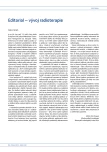Syndrome of Vena Cava Obstruction in Oncology
Authors:
F. Kohútek 1; I. Litvin 2; M. Tamášová 3; B. Bystrický 1
Authors‘ workplace:
Onkologické oddelenie, FN Trenčín
1; Rádiologické oddelenie, FN Trenčín
2; Klinika pneumológie a ftizeológie LF UK a UN Bratislava
3
Published in:
Klin Onkol 2013; 26(6): 434-437
Category:
Case Report
Overview
Background:
Superior vena cava syndrome (SVCO) is caused by compression of superior vena cava and restriction of blood flow to the heart. The most common underlying condition in cancer patients is lung cancer or other malignancy expanding in the upper mediastinum. SVCO belongs to oncological emergencies and requires a prompt diagnostic work‑ up and treatment.
Case 1:
A 79‑year‑ old man with a history of right‑ sided stage IIIB non‑small cell lung cancer, after two cycles of chemotherapy, was admitted to hospital with clinical signs of SVCO. The initial radiotherapy brought no relief of symptoms and due to deterioration of patient‘s status during the treatment we proceeded to self‑ expanding caval stent insertion. This was followed by immediate resolution of SVCO symptoms.
Case 2:
In the second case we describe a 56‑year‑ old female with a newly diagnosed diffuse large B cell lymphoma who presented with SVCO symptoms when referred to our outpatient chemotherapy department. She had no history of previous treatment and she complained of a rapid face and eye‑lid edema and intractable cough in the last two days. CT scan revealed mediastinal mass compressing the superior vena cava. Urgent anti‑lymphoma chemotherapy (RCHOP schedule) was commenced and yielded quick resolution of her symptoms.
Conclusion:
Superior vena cava syndrome is a medical emergency in oncological patients usually caused by external compression of cava by lung cancer, lymphoma, other tumors, less frequently, from a thrombosis of indwelling central venous catheter. Multidisciplinary cooperation among radiation and medical oncologists and interventional radiologists is needed in order to provide an early treatment without an undue delay.
Key words:
superior vena cava syndrome – non‑small‑cell lung carcinoma – diffuse large-B-cell lymphoma – radiotherapy – chemotherapy – stents
The authors declare they have no potential conflicts of interest concerning drugs, products, or services used in the study.
The Editorial Board declares that the manuscript met the ICMJE “uniform requirements” for biomedical papers.
Submitted:
9. 7. 2013
Accepted:
10. 8. 2013
Sources
1. Hunter W. The history of an aneurysm of the aorta with some remarks on aneurysms in general. Med Observ Inq (Lond) 1757; 1: 323– 357.
2. Musumeci ML, De Pasquale R, Tedeschi A et al. Non malignant superior vena cava syndrome. Int J Dermatol 2000; 39(12): 934– 936.
3. Krimsky WS, Behrens RJ, Kerkvliet GJ. Oncologic emergencies for the internist. Cleve Clin J Med 2002; 69(3): 209– 210.
4. Wilson LD, Detterbeck FC, Yahalom J. Clinical practice. Superior vena cava syndrome with malignant causes. N Engl J Med 2007; 356(18): 1862– 1869.
5. Pemberton HS. Sign of submerged goitre (letter). Lancet 1946; 251: 509.
6. Svoboda M, Bednaříková M, Palácová M. Akutní stavy v onkologii. In: Jurga LM et al (eds). Klinická a radiačná onkológia. 1. vyd. Martin: Osveta; 2010: 1350– 1351.
7. Rowell NP, Gleeson FV. Steroids, radiotherapy, chemotherapy and stents for superior vena caval obstruction in carcinoma of the bronchus: a systematic review. Clin Oncol (R Coll Radiol) 2002; 14(5): 338– 351.
8. Feugier P, Van Hoof A, Sebban C et al. Long‑term results of the R‑ CHOP study in the Treatment of elderly patients with diffuse large B‑ Cell lymphoma: a study by the Groupe d’Etude des Lymphomes de l’Adulte. J Clin Oncol 2005; 23(18): 4117– 4126.
9. Sherry CS, Diamond NG, Meyers TP et al. Successful treatment of superior vena cava syndrome by venous angioplasty. AJR Am J Roentgenol 1986; 147(4): 834– 835.
Labels
Paediatric clinical oncology Surgery Clinical oncologyArticle was published in
Clinical Oncology

2013 Issue 6
- Metamizole vs. Tramadol in Postoperative Analgesia
- Metamizole at a Glance and in Practice – Effective Non-Opioid Analgesic for All Ages
- Possibilities of Using Metamizole in the Treatment of Acute Primary Headaches
- Current Insights into the Antispasmodic and Analgesic Effects of Metamizole on the Gastrointestinal Tract
- Spasmolytic Effect of Metamizole
Most read in this issue
- Syndrome of Vena Cava Obstruction in Oncology
- Is Preoperative Bone Scintigraphy in Early Stage of Breast Cancer T1N0 Indicated and Meaningful?
- Smoking and Breast Cancer
- The Assessment of Quality of Life of Patients at Oncological Clinic – Pilot Study
